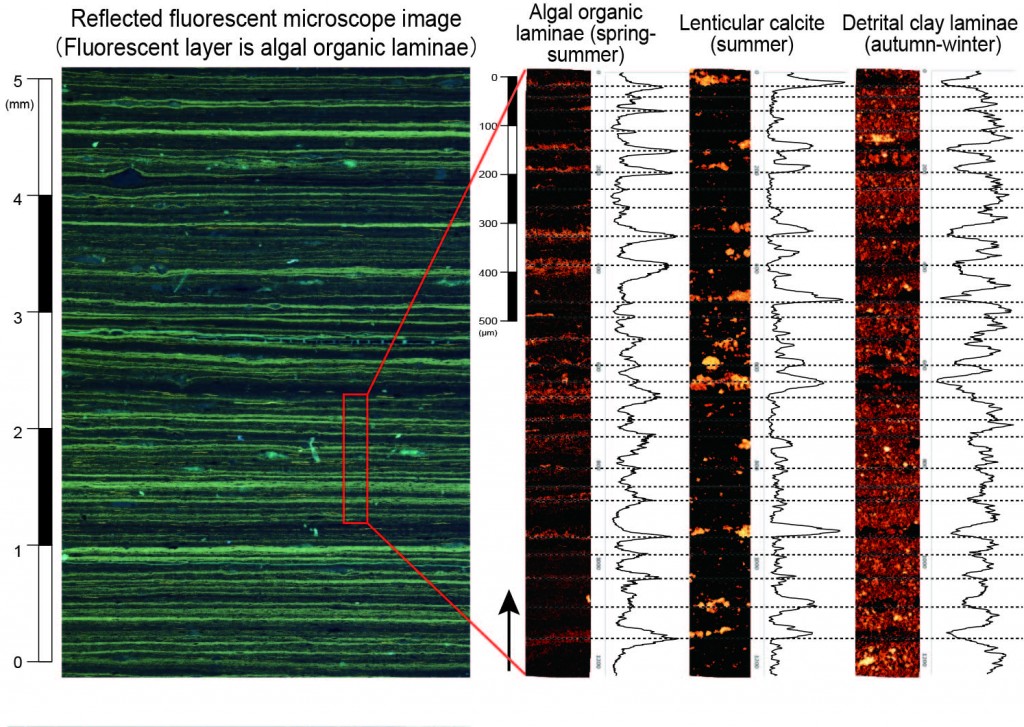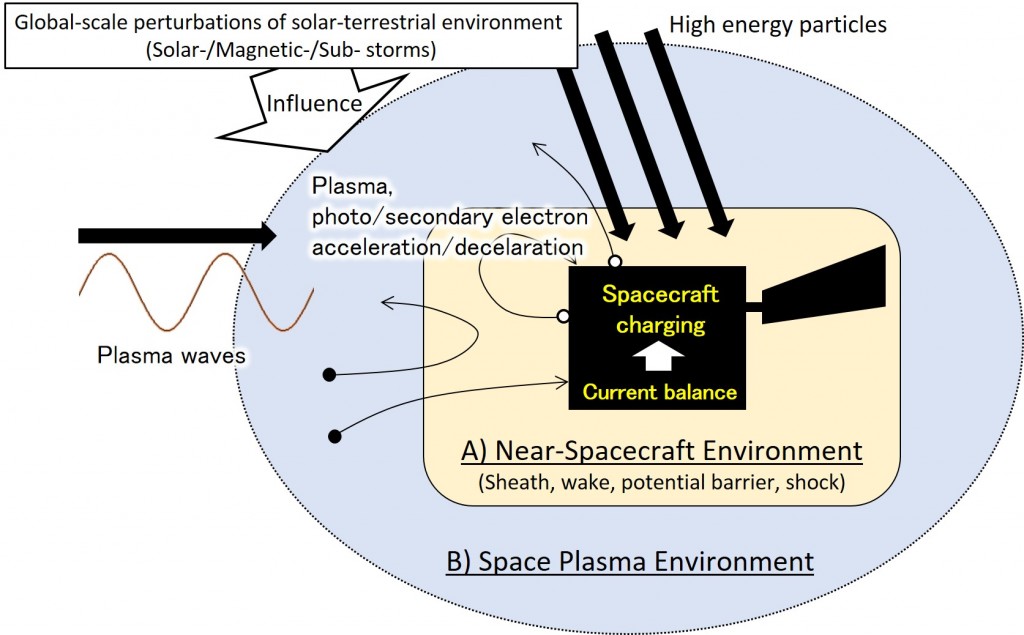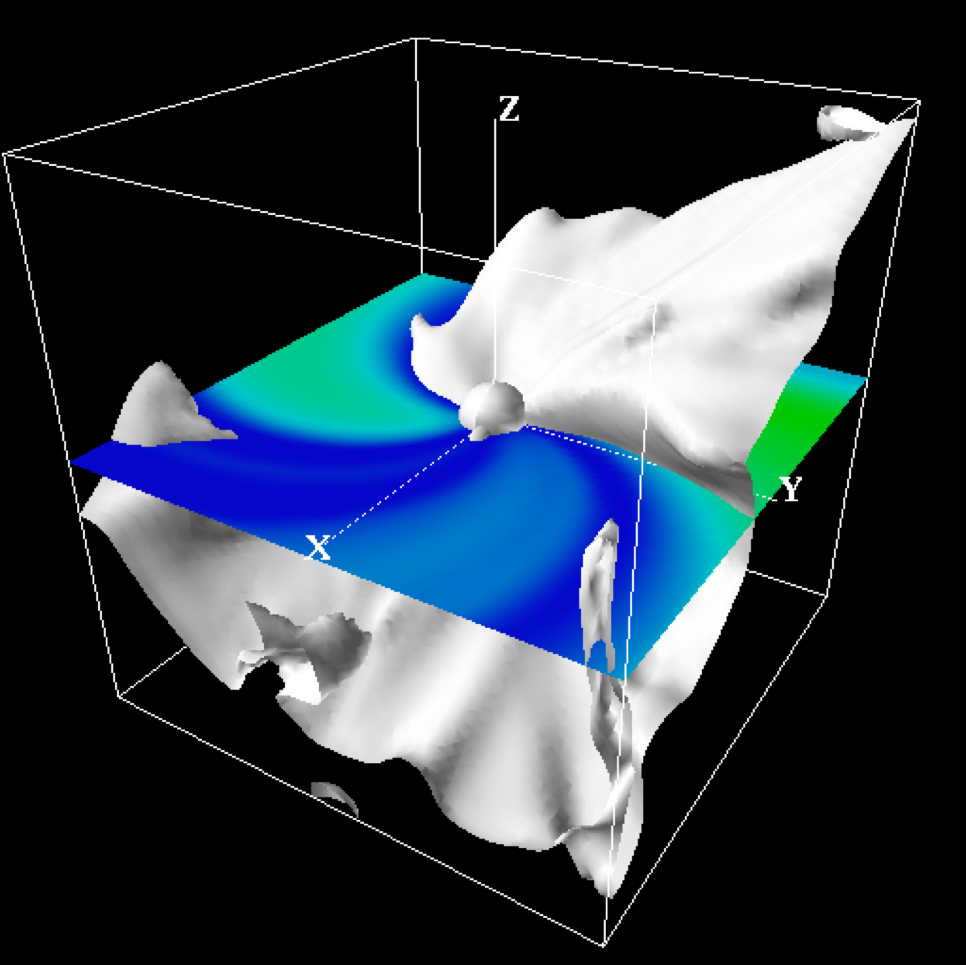Research Units (proposal-based)2016-2017
Akinori Saito/A01(Kyoto University)
Assessment and correction of influence of ionospheric disturbances on space-borne synthetic aperture radar measurments
Various types of disturbances are generated in the ionosphere by the variability of the energy inputs from the solar activity and the lower atmosphere to the Earth’s upper atmosphere. The sporadic and sudden change of the plasma density disturbances affects on the radio wave propagation through the ionosphere. Several social infrastructure systems such as global navigation satellite system and satellite communication/broadcast systems suffer from the propagation delay and interference of their radio waves. One of the systems that are influenced by the space weather phenomena is satellite-borne Synthetic Aperture Radar (SAR) system. In this study, the ionospheric data will be investigated to assess influence of ionospheric disturbances on space-borne SAR measurements. The method to correct the ionospheric effect on the SAR data will be also studied. This study will contribute to establish the social system that is robust to the variability of the solar-terrestrial environment.
Hiroshi Yasuda/A01(Hiroshima University)
Sharing of the Real-Time Data on Cosmic Radiation Exposure in the Solar-Terrestrial Environment
As one of the critical subjects of the A01 ‘Forecast System’ group, this study is focusing on making a computer program to determine radiation exposure doses from solar energetic particles in aviation and space immediately after a large-scale solar flare happens. In more details, neutron monitoring data placed on the ground in polar regions and flux data of solar particles measured using satellites are to be collected in real time with 5-min intervals and, accordingly, radiation dose rate at any point and time in the solar terrestrial environment (including an atmospheric environment) could be estimated and shared within several hours after a ground level enhancement (GLE) of cosmic radiations is detected. The estimated doses and relevant guides would be used for avoiding potential radiation exposures, e.g., by rescheduling of air flights.
Tetsu Anan/A02(Kyoto University)
The ideal spectral line for coronal coronal magnetic field modeling
Solar flares and coronal mass ejections that change solar-terrestrial environment are interpreted as releases of magnetic energy stored in the solar corona. The magnetic field in the solar corona is extrapolated from the field in the solar photosphere, because it is difficult to measure the coronal field. Recently, it is possible to measure the magnetic field in the chromosphere, which is interface between the photosphere and the corona. In this study, we develop a new spectro-polarimeter of the Domeless Solar Telescope at Hida Observatory to measure the magnetic field in the photosphere, upper photosphere, the chromosphere, and upper chromosphere, simultaneously. By applying coronal field modeling method to the measured magnetic field map, and comparing coronal loops, which seem to display field lines, we study which spectral line gives us the most precise coronal field extrapolation.
Kyoko Watanabe/A02(National Defense Academy of Japan)
Total solar flare spectra model
Impulsive energy release phenomena, such as solar flares, sometimes affect to the solar-terrestrial environment. We usually use the soft X-ray flux as the index of flare scale. However, the magnitude of the effect to the solar-terrestrial environment is not proportional to the GOES X-ray class. To identify the relationship between solar flare phenomena and influence to the solar-terrestrial environment, we need to understand the full spectrum of solar flares. For this purpose, we are performing statistical analysis of electromagnetic spectra of solar flares.
In this study, we will discuss the relationship between the fundamental flare parameters (such as the GOES X-ray class, flare duration etc.) and the flux of other emissions (whole electromagnetic spectrum from radio to gamma-ray and/or energetic particles). We will also compare this statistical result with the radiation obtained from one-dimensional hydrodynamic numerical simulation. We plan to develop the model that can estimate total spectrum of electromagnetic radiation and high energy particles from solar flares without spectral observations.
Takuo Tsuda/A03( University of Electro-Communications) Investigation into metallic ions/atoms variation induced by energetic particle precipitation
The sporadic E (Es) layer is an ionospheric disturbance. Since the Es layer can affect HF radio communications, it is important to understand variation in the Es layer and to make its prediction. In this study, we focus on metallic ions, which are major ion compositions of the Es layer, as well as metallic atoms, which are reservoirs of the metallic ions. Based on satellite data, we investigate energetic particle precipitation (EPP) effects to variation in the metallic ions and atoms. We have a consideration on the ion-chemistry to estimate the metallic ions variation induced by the EPP. In this way, we are going to make a contribution to understanding the ionospheric disturbances such as the Es layer in collaboration with the A03 group, which would be useful for promoting its prediction research.
Hitoshi Hasegawa/A04(Nagoya University)
Reconstruction of decadal-scale climate change and its relation to Solar activity during the Cretaceous
It has been suggested that alterations and cyclic fluctuations in Solar activity may be linked to climate change on Earth. However, validity of its linkage and their controlling mechanisms remain highly controversial. In this study, we are trying to reconstruct annual- to decadal-scale climate change during the Cretaceous period by using lacustrine varve record (Shinekhudag Formation) in Mongolia. We are trying to detect a sign of Solar-forced decadal climatic change in the Cretaceous from the unique varve record.
Figure (left) Photomicrograph of reflected fluorescent image of micrometer-scale laminae (varve) in Cretaceous lacustrine deposits in Mongolia. (right) Elemental composition of micrometer-scale laminae, reflecting seasonal cyclicities.
Hitoshi Fujiwara/A04(Seikei University)
Development of a photochemical model for H2O and HOx in the mesosphere and lower thermosphere
The purpose of this study is to develop a photochemical model which describes spatio-temporal variations of H2O and HOx in the mesosphere and lower thermosphere. Since the species, H2O and HOx, are closely related to the noctilucent cloud and ozone depletion in the upper stratosphere and mesosphere, both the observations and modeling studies of the species are necessary for understanding the global environmental changes. In the present project, we will start modeling studies to investigate the variations of H2O and HOx depending on changes of solar activities and precipitating high energy particles. We will also build the new photochemical model onto the whole atmosphere-ionosphere model, Ground-to-topside model of Atmosphere and Ionosphere for Aeronomy (GAIA), which successfully describes some mesosphere-thermosphere-ionosphere (MTI) phenomena caused by lower atmospheric effects. The new modeling activity will have contributions to understand energetic coupling between below and above regions through dynamical and chemical processes in the MTI region.
Yuhji Kuroda/A04(Meteorological Research Institute)
Elucidation of the solar influence on oceanic and climate variability
The objective of the present project is to clarify how coupled atmospheric and oceanic variabilities are created associated with the solar variability. To this end, analysis using a long term simulation of the earth system model of the Meteorological Research Institute is performed, as well as that of observational oceanic and atmospheric data. Cooperating mainly with K. Kodera of ISEE of Nagoya University, we are planning to perform the following themes:
1, Observational data analysis: Historical temperature and salinity data up to 700 m depth and atmospheric reanalysis data are used to extract the oceanic mode of variability that influences climate.
2, Simulation of the earth system model and its analysis: Historical as well as idealized experiments using the earth system model are performed to clarify solar influence on ocean and climate. Analysis is performed in comparison with those of the observation.
Hideyuki Hotta/B01(Chiba University)
Precise estimation of mean-field parameter using large-scale calculation in the solar convection zone
A04 team in PSTEP is trying to predict the solar activity 5 years before the solar maximum using the mean field model and the surface flux transport model. Although these models require less numerical resource and easily carry out data assimilation with numerical simulation and observation data, these must have a number of assumptions on turbulent parameters. This can be problems when we study prediction and extreme situations like the Maunder minimum. In this study, we estimate turbulent parameter required in A04 study using calculations of the thermal convection in the solar interior. We are trying to estimate the turbulent parameters for the angular momentum transport. The test field method is widely used for estimating the turbulent parameters for the generation of the magnetic field, but there is no good estimation method for the angular momentum transport. In this study we plan to extend the test field method for this end. In addition, we have found that the turbulent magnetic energy is comparable to the turbulent kinetic energy in our extremely high resolution calculations. I also need to re-estimate the turbulent parameter for the magnetic generation in this situation.
Takanobu Amano/B01( Tokyo University)
Understanding Inner-Magnetospheric Elementary Processes via Large-scale Kinetic Simulations
Development of realistic numerical models for the inner magnetosphere has been a key issue in predicting the Geospace environment. An appropriate model for the inner magnetosphere has to take into account both the kinetic effect of energetic ring current particles and the self-consistent coupling between the ring current population and the thermal plasma as well as the electromagnetic field. This has not been possible in standard numerical models in space physics. This work employs a novel numerical model that takes into account the self-consistent coupling between the cold (ion and electron) fluid and the energetic particles, for which the kinetic effect is fully taken into account. We investigate elementary processes occurring in the inner magnetosphere that are dominated by the ring current dynamics.
This allows us to understand magnetohydrodynamic waves and global magnetic field variations caused by the ring current. Our final goal is to understand the acceleration and transport of relativistic radiation belt electrons associated with these phenomena.
Yoshiya Kasahara/B01(Kanazawa University)
New analysis system of the Earth’s magnetosphere using the propagation characteristics of plasma wave
We develop new techniques to deduce overall plasma environment in the Earth’s magnetosphere using the propagation characteristics of plasma waves from in situ measurement data by scientific satellites. To achieve this goal, we propose algorithms to derive wave normal and Poynting vectors of ELF/VLF waves accurately from the data obtained by plasma wave instruments and to estimate the density profile in the Earth’s magnetosphere and/or spatial distribution of the wave source. These techniques are referred to as “inverse problem”. We try to solve the problem by making use of “wave distribution function” method, which is one of data analysis methods to estimate propagation parameters such as wave normal vector, and “ray tracing” technique, by which propagation paths of the plasma waves are theoretically determined.
Kumiko Hori/B01(Nagoya University)
A variety of solar periodic activities and rotating MHD waves
MHD waves excited in the solar convection zone can produce a variety of time variations of the stellar magnetic field. To explore the relevance of these waves in data, we will investigate whether there are any significant periodic activities other than the 11 years cycles, what its spatial and temporal structures look like, and what are its links to the global dynamics within the convection zone. Also, we intend to develop the theory of MHD waves in rotating and stratified fluids in order to gain the physical basis of wave motions that can be excited in the convection zone including the tachocline. The advantage, if successful, is that the wave speeds will enable us to infer the physical background state of the stellar deep interior. Therefore the study has the potential to constrain global solar dynamo models for predicting the next solar cycle as well as the solar terrestrial environment.
Yoshifumi Kimura/B01( Nagoya University)
Mathematical modeling for predicting the effect of the solar activities on the terrestrial environment
The objective of this project is by using mathematical modeling techniques to clarify the mechanisms and the mathematical structures of the periodic/intermittent solar activities and to understanding their effects on the terrestrial environments. Cooperating with T. Ohira (prof.) and F. Fujie (assc. prof.) of the Graduate School of Mathematics, Nagoya University, we conduct the research of the following two themes:
[a] Considering and modeling of the nonlinear phenomena in the solar activities: (1) reconnection models of vortex and magnetic flux tubes, (2) perturbation model of the magnetic dipole of the earth.
[b] Construction of a mathematical index to measure the effect of solar activities on the terrestrial environment: (1) development of an index to measure the fragility of electrical and communication network using graph theory, (2) study of the transient phenomena in the network using graph dynamical systems.
Yohei Miyake/B01(Kobe University)
Spacecraft surface charging model predictions based on interaction processes between spacecraft systems and space weather phenomena
The ultimate goal of this research is to advance understanding via numerical simulations in close linkage between spacecraft charging phenomena and dynamically-changing space environment associated with solar activities, so as to help develop the space weather forecast system. This would be achieved by reproducing transient processes of plasma interactions with solid spacecraft surfaces. The self-consistent model used in this study will provide accurate predictions on spacecraft charging affected by plasma acceleration/deceleration processes within plasma sheath, wake, and potential barrier, as well as plasma wave activities arising in space. This enables us to make systematic assessment of space weather effects on artificial spacecraft systems as an important social infrastructure.
Tomoaki Matsumoto/B01(Hosei University)
A dynamical model of the heliosphere with the adaptive mesh refinement
A change in the heliospheric environment plays an important role in the modulation of the galactic cosmic rays (GCRs); the magnetic field structure and the speed of the solar wind affect GCR transport in the heliosphere. Since the heliospheric environment is affected by the solar wind activities, we have been developing a framework for simulating the heliosphere by using MHD simulations. The heliospheric current sheet (HCS) is an important channel for GCR transport, the numerical simulations should resolve the HCS with a high resolution. We therefore adopt a numerical simulation code, SFUMATO, which employs the adaptive mesh refinement (AMR) technique. Our heliospheric model developed here will also reproduce the heliospheric environment in the grand solar minima. We have a plan to reproduce GCR modulation in the grand solar minima by using our heliospheric model, and would like to investigate the GCR transport in these periods.
Hideharu Akiyoshi/B01(National Institute for Environmental Studies)
A study on the effect of solar proton events on the ozone layer and earth climate using a chemistry-climate model
In this study, we investigate the effect of the solar proton events on the middle and lower atmosphere through the variations in atmospheric constituents such as NOx, nitric acid, and ozone, and clarify the relationship between solar activity variation and variations in the middle and lower atmosphere. For this purpose, we perform numerical simulations of the effect of solar proton event using the NIES three-dimensional chemistry-climate model, which calculates chemical reactions, photolysis, and the 3-D distribution of neutral atmospheric constituents as well as the earth climate, and a RIKEN chemical box model, which includes radiolysis processes, ion reactions, and ion recombination reactions as well as the chemical reactions and photolysis in the 3-D chemistry-climate model.
We plan to make a simulation for the Halloween Event, which occurred in 2003, and compare the results with satellite observation data of NOx, nitric acid, and ozone for the model validation. We also plan to make a simulation for the huge solar proton event in 1859 (Carrington Event) and analyze the effects on the middle and lower atmosphere.
Muneyuki Muranushi/B01(Institute of Physical and Chemical Research)
Development of Solar Flare Forecast System using Deep Learning
Every day we hear about deep learning — the technology of simulating neural network on computer, that enabled go-playing-AIs, self driving cars and many other things. However, developers of deep learning requires input of big data, mainly held by the IT giants. At this point, the observational data of Sun serves unique opportunity to researchers like us, because it covers decades of observations of a subject whose fundamental physical laws well understood, yet whose behavior remain challenging to predict. Synergy of machine learning and solar physics may bring a breakthrough here. Machine learning and physics share its goal in constructing a predictive model based on observational facts, and we believe we can collaborate.
In this research, we apply deep learning to flare prediction studies, study which method to use, and quantitatively analyse the prediction performance. We contribute to solar physics by mechanization of the space weather know-hows, and by visualization of the features recognized by machine learning.



